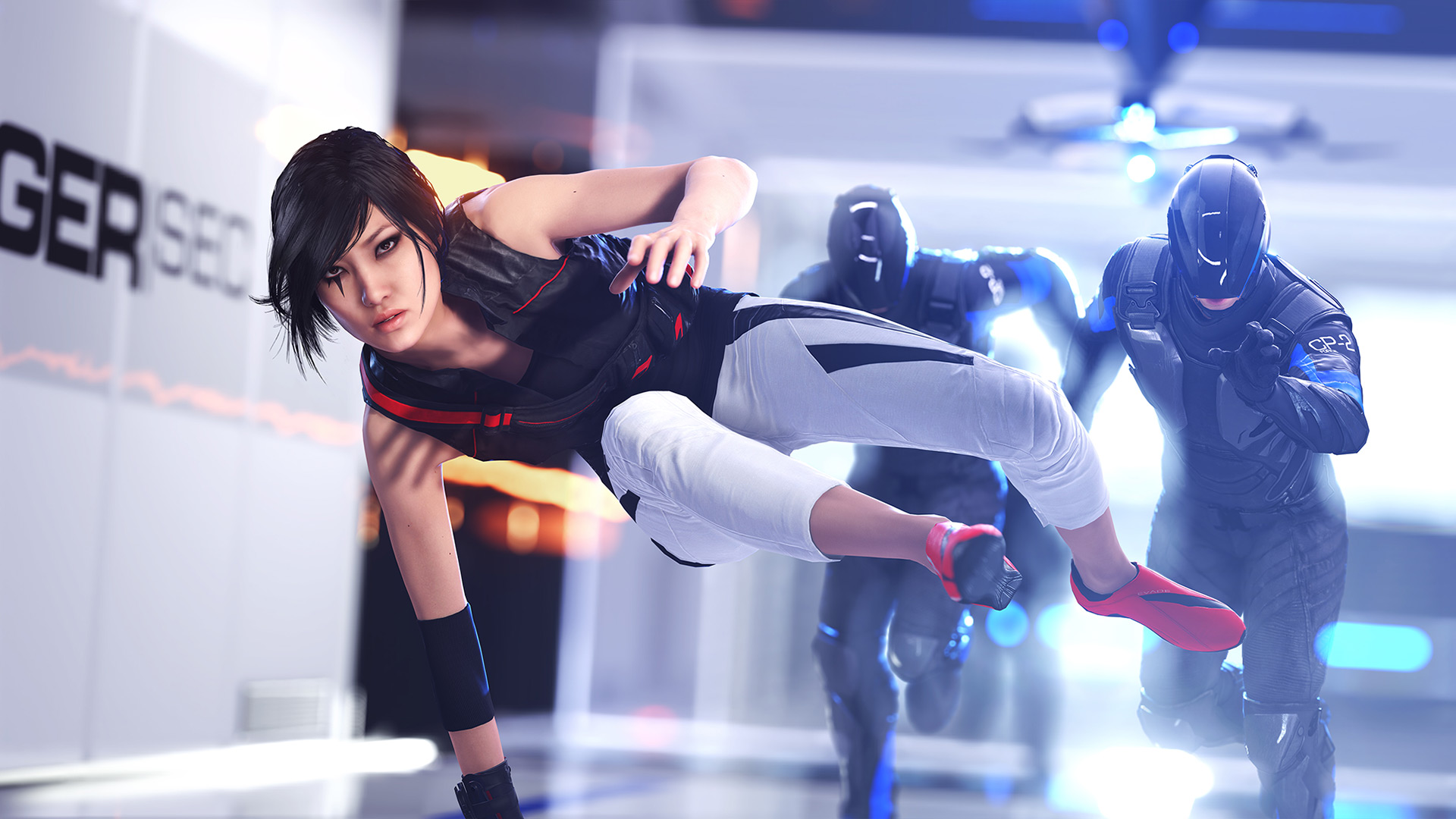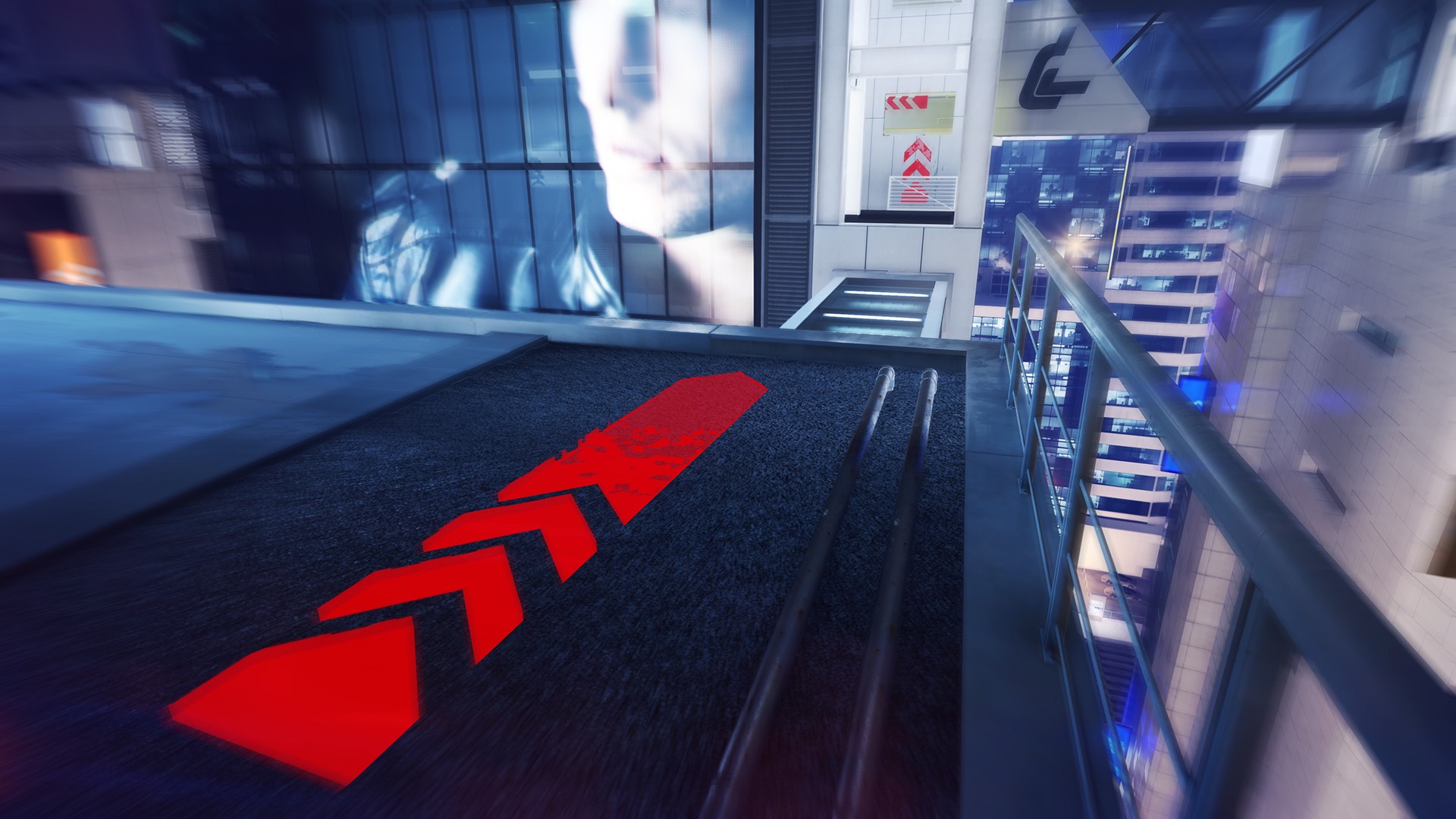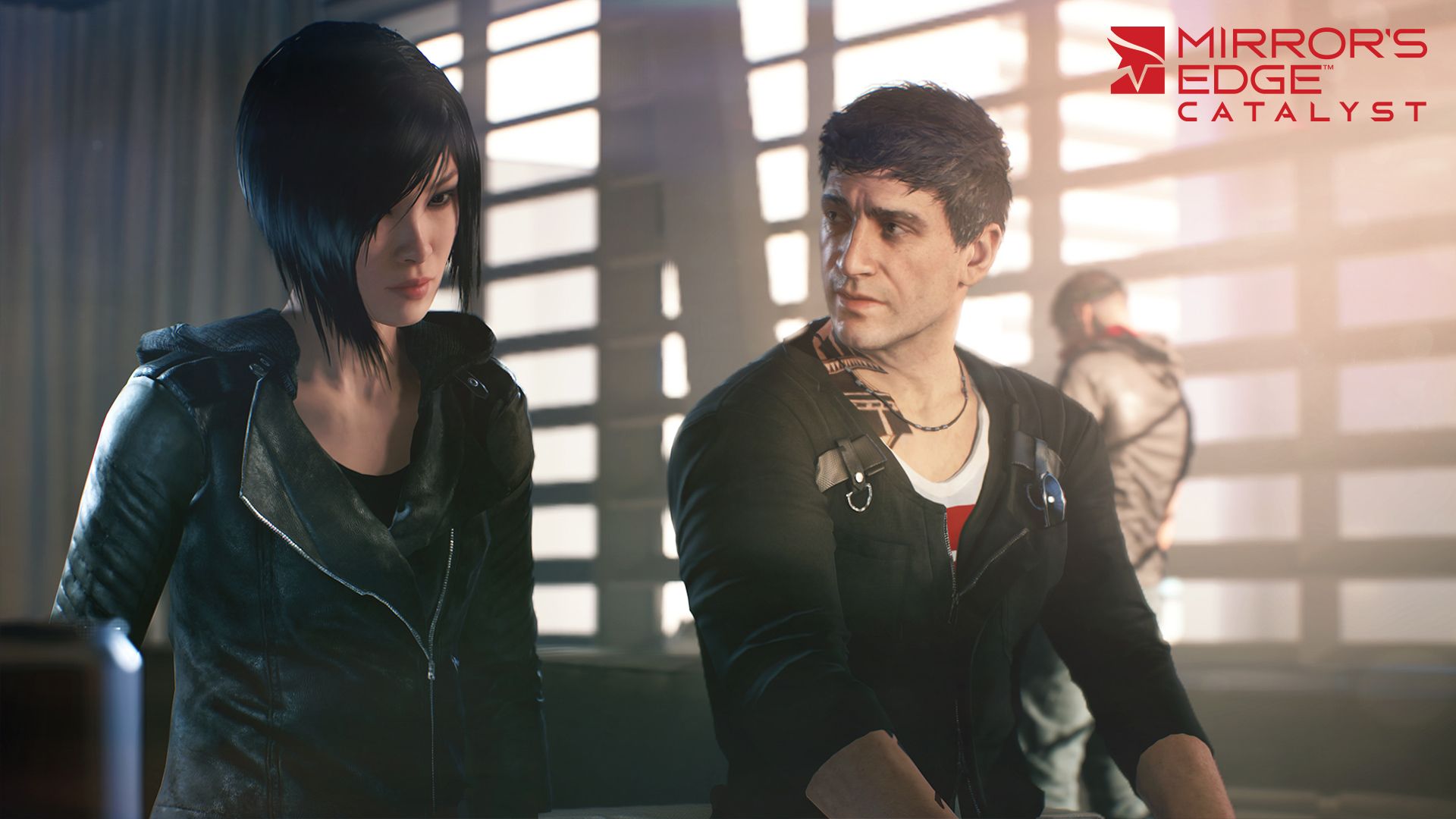
Oppression is a tool that best benefits from nuance and if Mirror’s Edge Catalyst achieves something well, it’s in creating a beautiful world that’s surging with danger beyond its polished veneer. Billboards advertise the latest in technology for the Grid but paint a false picture of happiness, catering to the rat race for wealth and social status. By comparison, the Runners seem self-righteous but the actual impression DICE seemed to be going for was a band of rogues that refuses to play by the rules. And in true fashion, Mirror’s Edge Catalyst doesn’t exactly play by the rules with regards to conventional game design. That being said, this game draws to extremes. It can either be interesting and unique, brimming with a fun concept that’s facilitated by its core gameplay, or it can be difficult and obtuse, filled with overly-routine missions and wonky controls that take away from its main appeal.
"Despite their recognizable archetypes, the characters in Mirror’s Edge are miles above those in the original game and probably some steps above your typical open world experience."
In this origins/reboot story, Faith Connors is a Runner that’s being released from prison after years following a botched job for the criminal-esque Dogen. Interesting story right there but the key details of Faith’s incarceration are relegated to the comic book Mirror’s Edge Exordium. A compelling plot develops from the outset as Faith is rescued by Icarus, a new Runner in the cabal, and subsequently cut off from the employ Grid to return to her normal life. “Normal” doesn’t last very long though as Faith runs afoul of KrugerSec and eventually faces consequences that shake the very world of the Runners to the core.
There are plenty of loose ends to wrap up – cabal leader Noah, who raised Faith from childhood, is the usual kind but firm leader; Icarus is an arrogant, cool but altogether loyal ally; Plastic is your quirky computer genius with quirky social skills because quirkedy quirk quirk (though she admittedly has some funny exchanges with Noah); and Dogen is an intriguing mix of ruthless self-serving and coldly inviting.
Despite their recognizable archetypes, the characters in Mirror’s Edge are miles above those in the original game and probably some steps above your typical open world experience. The facial animation and graphics do some serious work in this regard, as you notice Noah’s pained glances and wrinkles while marveling at Plastic’s nervous mannerisms upon close physical contact (during the cutscenes, of course). In essence, these characters will involve you in the story without much problem but their depth, along with the story, feels superficial at times. There are hints of something deeper and more scratching isn’t guaranteed to unearth something new. The story throws terms like Reflection and OmniStat at you without outright explaining their significance. Noah’s relationship with Faith isn’t expounded on much more than what the player is willing to know.
Interestingly, this approach works pretty well for Faith’s motivations and explaining her back-story. She’s a girl who’s had a hard life, as flashbacks to her grim past indicate, but she’s always running forward, looking to the next Beat and trying to find some sense of satisfaction in pleasing Noah and beating Icarus. A little more charisma wouldn’t have hurt at times. Regardless, despite the story’s typical evil corporation machinations, it’s interesting enough to keep you playing.
"Mirror’s Edge Catalyst works hard to hold your hand with Runner Vision presenting a pixilated red line indicating a solid route through your surroundings."
Unlike the first game, Mirror’s Edge Catalyst is open world. Don’t expect Geraldo del Rivero-style narrative masterpieces – Catalyst‘s activities are very cut and dry outside of the story missions. You can take part in Dash events created by the developer, effectively timed courses that challenge you to find the shortest route imaginable. Or you can indulge in timed deliveries and diversions, which prove incredibly stingy with the time they give the player. Then there are activities like collecting security chips, shutting down comm link towers and evading the authorities (which always ends in running to the nearest safe house), and Gridnode runs which we’ll get to in a bit.
Mirror’s Edge Catalyst works hard to hold your hand with Runner Vision presenting a pixilated red line indicating a solid route through your surroundings. At times, it even displays ghostly versions of Faith executing certain moves to give you a better idea of how to cross some obstacles. This is a significant improvement over the first game, even if the red lines seemingly disappear during the most crucial moments like escaping KrugerSec forces.
It’s also worth noting that though the combat is improved over the original, it still isn’t significantly memorable. Knocking enemies into each other and performing combos is fine for the first few times but later, the more difficult foes are defeated by simply combat shifting around and kicking them in the back. The only real exception is the Sentinel with his wide ranging and powerful attacks but only just barely. The variety of enemy types isn’t anything special but it can make for a few pitched battles when trying to avoid long-range shooters, short-range Shock Protectors and melee-based Protectors.
Now onto one of the bigger pains of the experience: Diversions. The diversions work as thus – navigate to a group of enemies, smack one in the face, move along to the next target, repeat. It’s an interesting activity in making use of the Traversal Attacks and challenging you to keep your Focus Meter from dwindling. But they are downright annoying – the time extension given before moving to the next target never feels enough. It’s especially annoying when trying to find the next waypoint in the middle of enemies. Also, for some damn reason, rather than showing you the next waypoint on the mini-map, it shows you the home base for evading KrugerSec. This results in confusion and lost time, as if the game wasn’t trying to screw you over enough as is.
"However, when the game does challenge you to think and move carefully, it tends to get the important things right. This is seen mostly in the story missions…"
Such activities usually highlight a rather troubling trend with Mirror’s Edge Catalyst: The traversal mechanics can be extremely wonky. The major challenges mirror (no pun intended) the original wherein you’d struggle to find the next way to go. However, instead of outright fighting the complicated controls, you have to deal with unexpected responses. You might want to grab on to a ledge above you but because you held on to Left Bumper for longer than a second, Faith will wall run on the wall and off to her doom.
Let’s not forget one amazing moment where I was trying to evade capture, swinging across poles when suddenly the grappling hook homed in on a point – off screen, out of my view – rather than jumping to the next pole, sending me to death. There were also odd moments where Faith would stumble or fall multiple times over a period of very small steps. Those are some of the more rage inducing moments of Mirror’s Edge Catalyst.
However, when the game does challenge you to think and move carefully, it tends to get the important things right. This is seen mostly in the story missions, especially when it comes to disabling a building’s vital systems that protect it from earthquakes and wrecking the entire structure. The entire sequence is composed of wall-running, climbing, wall-kicking, grappling and a particularly dizzying experience above a crane. The Gridnode runs are also a good example – you’ll navigate a futuristic, enclosed room, avoiding tripwires and making your way to the computer up top to unlock a fast travel point. I’m not usually one for these fast travel tower unlocks but Mirror’s Edge Catalyst turns it into an interesting yet challenging activity.
Outside in the open world, however, Mirror’s Edge Catalyst‘s traversal feels unbalanced. It never quite approaches the highs of the story missions. The side missions are fairly routine and sooner or later, you’ll look to the user-created time trials to really motivate you to run. The problem then is the movement. When the very basis of the gameplay can be fairly unreliable at times, it affects the entire game.
"Mirror’s Edge Catalyst isn’t a bad game. At times, it feels incredibly polished and at others, it could use more work."
The visuals and sound are mostly on point, especially the sound effects which accurately represent Faith’s footsteps across a variety of surfaces. Though the aesthetics are quite appealing, it can work against the game in several significant ways, like transparent surfaces in dark rooms with funky lighting that can throw you off. And though the graphics can be described as beautiful, there’s a large amount of pop-in at times on the Xbox One. During some conversations, you’ll notice NPC facial features soften, perhaps due to this version’s low resolution.
The in-game destruction is also a little odd – at times, it was incredibly impressive and at others, it feels pretty shabby (and this is by DICE standards, mind you). The jaggies are also plenty noticeable but anything to get this game running at 60 FPS we suppose. The frame rate does see some drops every now and then but nothing too significant. It’s perhaps more annoying to see the non-in-game cutscenes in 30 FPS but that’s an aesthetic choice that does lend to some cinematic moments.
Straightforward first person parkour isn’t anything new. Mirror’s Edge might have wowed us back in 2008 but there have been a number of games that have taken significant in-roads to the first person movement genre (Dying Light and Portal 2, for instance but even third person shooters like Sunset Overdrive found fun ways to play with extraordinary movement). With all the different things done in the genre over the past eight years, Mirror’s Edge Catalyst seems to showcase the best and worst aspects of going back to a pure movement-based game. For all the options given while travelling, there really is only one way to get from one district to another. Some areas lead to dead ends or dead drops as the situation may dictate, causing you to plummet to your now repetitive doom. The sensation of “How do I get over there?” would often be replaced by dread when noticing how many buildings stood between me and my destination.
Mirror’s Edge Catalyst isn’t a bad game. At times, it feels incredibly polished and at others, it could use more work. The story is fun to run through once and the open world is good for a few diversions and time trials that won’t require you to sink countless hours into one sitting for significant progress. Faith Connors may not save us all in her somewhat-triumphant return to gaming but she will entertain – and be imminently forgotten – until the next triple-A sequel.
This game was reviewed on the Xbox One.
Appealing visual art style with some fairly nice looking animations and details. Campaign is fun to play the first time, especially thanks to some intriguing characters and the polished levels. Parkour mechanics feel easier to get into, especially with the inclusion of Runner Vision. Time trials and Dashes can be fun to complete in your spare time while the Gridnode runs deliver more patient platforming.
Story doesn't exactly fill you in on all the details at any given moment. Combat tends to get pretty repetitive. Movement controls sometimes deliver random, undesired results, causing unintentional deaths. Some open world side missions feel unoriginal and some, like diversions, are outright annoying. Open world activities as a whole feels less polished than the story. Graphical issues like pop-in and jaggies present.


















